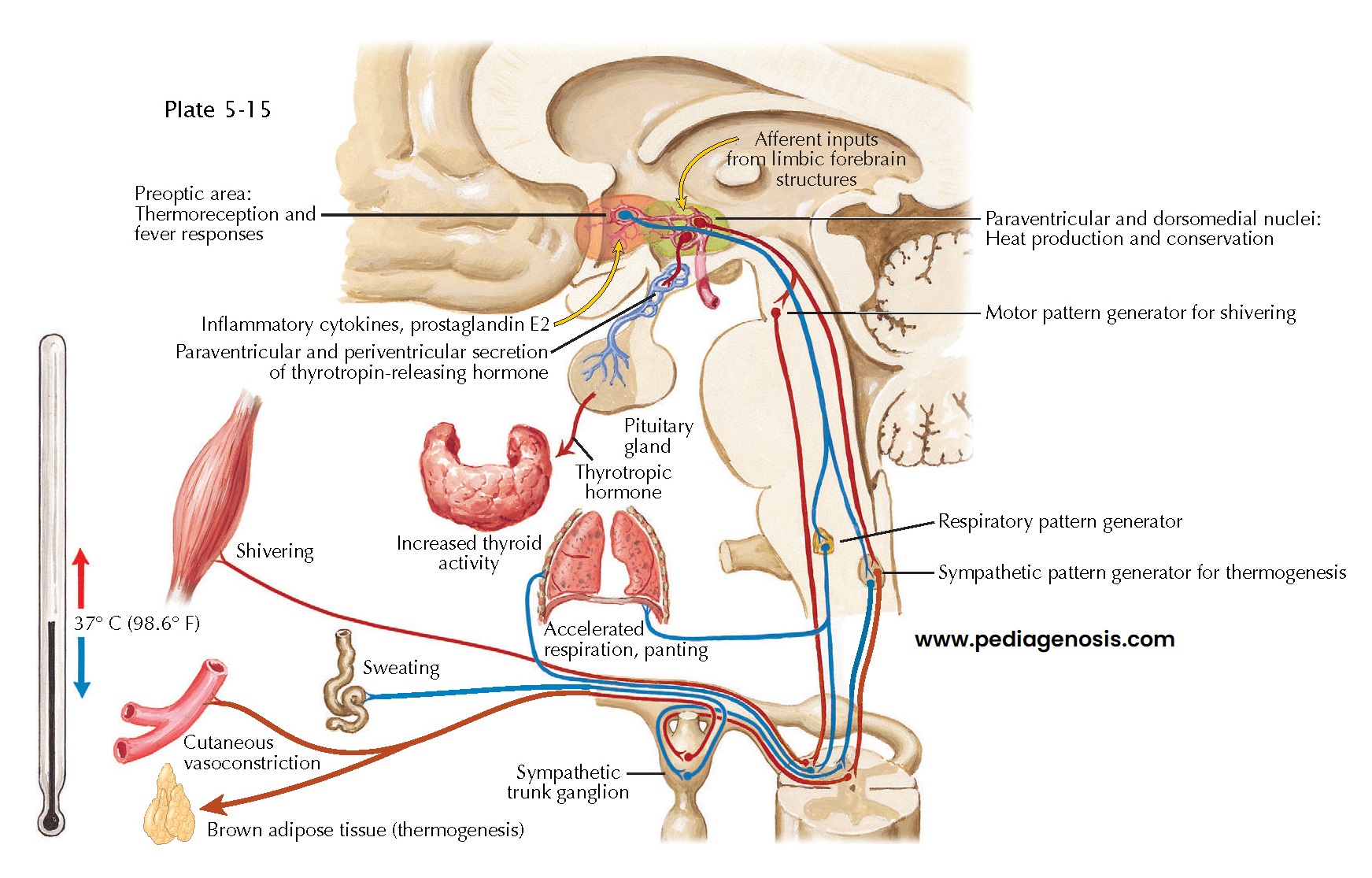Temperature Regulation
 |
| HYPOTHALAMIC REGULATION OF BODY TEMPERATURE |
One of the key roles of the hypothalamus is in main- taining an even body temperature. This is necessary for optimal function of neurons, metabolic enzymes, and actions of the immune system. The preoptic area contains neurons that are specialized for thermoreception. These are located in close proximity to the neurons that detect osmolality and control fluid and electrolyte balance, and some neurons may have dual roles in both systems. (For example, on a hot day it is necessary to conserve fluid for use by sweat glands to maintain cooling.) Some preoptic neurons them- selves are thermoreceptors, but many also receive inputs from the skin, which informs them about the external temperature. Warm-responsive neurons inhibit a series of cell groups that increase body temperature, including the paraventricular and dorsomedial hypothalamic nuclei and the raphe nuclei in the medulla. These latter cell groups activate the sympathetic nervous system to increase body temperature by two major pathways. The first of these is heat generation, due to activation of brown adipose tissue. Once thought to be present only in small mammals, including newborn humans, recent studies have shown that even adult humans have residual brown adipose tissue. Brown adipose is found in small patches along the back and consists of adipose cells that contain large numbers of mitochondria and express uncoupling protein I. This protein permits mitochondria to burn fat to produce heat.
The other major
way to increase body temperature is by heat conservation. Particularly in
larger mammals, such as adult humans, the body makes sufficient heat from its
internal metabolism so that body temperature can be increased merely by
shunting blood flow away from the skin to deep vascular beds. In animals with
fur, piloerection, another sympathetic response, increases the thickness of the
fur coat and thus conserves heat. Humans also have piloerection called gooseflesh,
but this is not nearly as effective in heat conservation. The thermogenic
(brown adipose) and heat-conserving mechanisms are coordinated by medullary
raphe neurons that activate both pathways.
A third
mechanism for generating heat is by increased muscle activity or shivering.
Less is known about this pathway, but it is presumed that hypothalamic neurons
activate motor pattern generators that cause increased muscle activity, which
is thermogenic. All three mecha- nisms require energy, and so the heat
production system also activates the cardiovascular system to increase cardiac
output and the respiratory system to maintain blood oxygenation.
Anterior
pituitary hormones do not seem to play much of a role in the regulation of body
temperature over a period of minutes or even hours, although in the absence of
thyroid hormone, body temperature falls. Body temperature also rises (during
the active cycle) and falls (during the sleep cycle) daily, and this typically
occurs before the onset of motor activity or rest, and so is not due to a
simple change in muscle activity. There are also changes in body temperature
during the menstrual cycle, which may reflect the fact that the preoptic area
is also involved in reproductive function.
In addition to
inhibiting the heat production and conservation systems, warm-sensitive neurons
in the preoptic area also increase blood flow to the skin as well as sweating,
to permit heat loss, and increase vasopressin secretion, which permits
conservation of fluids that are necessary to support increased sweating.
Sweating is mediated by two sets of sympathetic nerves, one of which is
noradrenergic and the other cholinergic. The cholinergic sympathetic input
appears to be of primary importance for thermoregulatory sweating, whereas the
noradrenergic axons may be more important for emotional sweating.
Paroxysmal hypothermia is a rare neurologic disorder, most often seen in individuals who have agenesis of the corpus callosum (due to a failure of the anterior wall of the third ventricle to develop properly) or a congenital tumor or other lesion affecting the preoptic area. Such individuals have periods of several days at a time during which their body temperature drops to about 30° C, and they lapse into a stuporous state. Presumably this represents an unusual hypothalamic response, similar to that seen in hibernation states, but there have been too few patients with this syndrome to study it closely.




